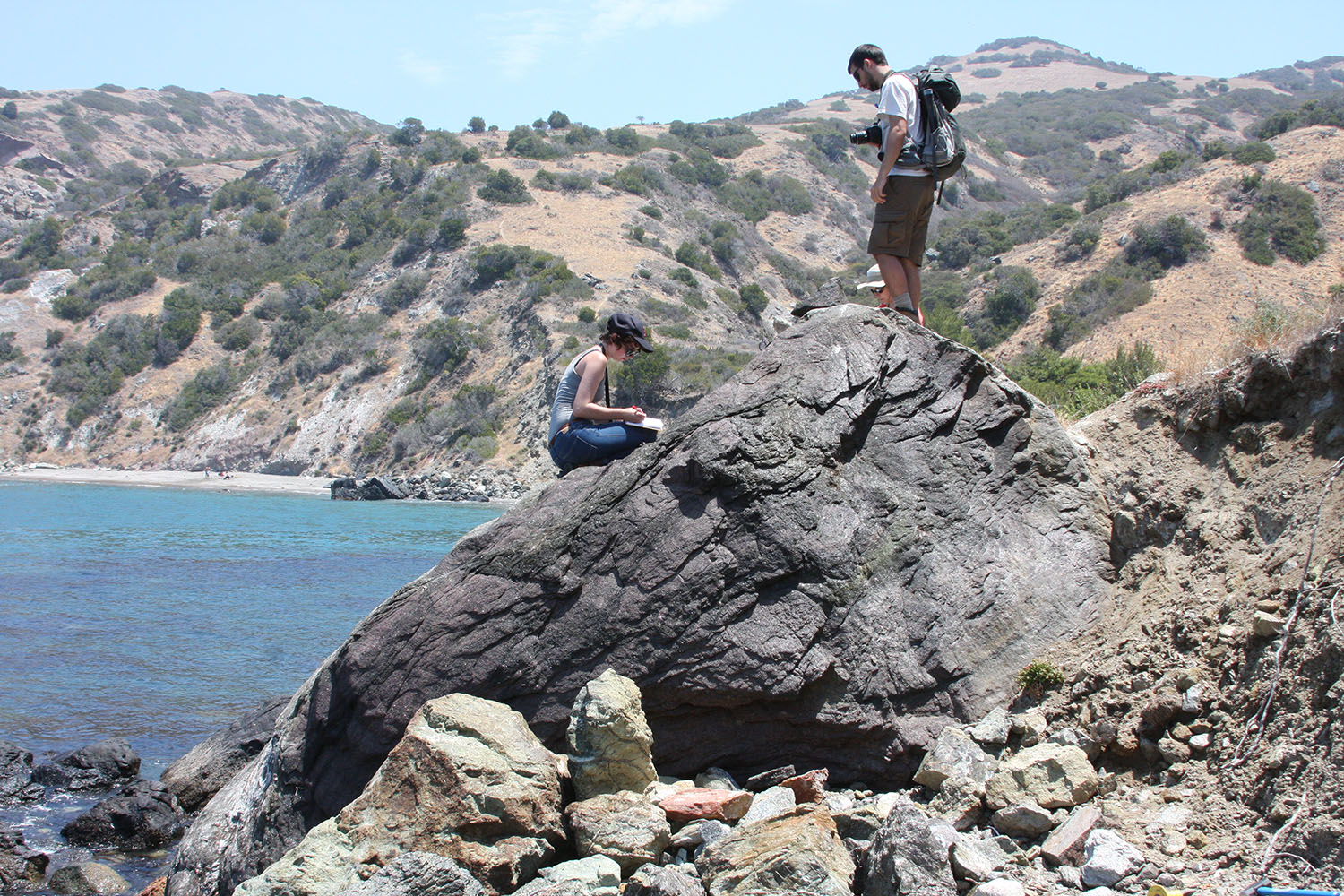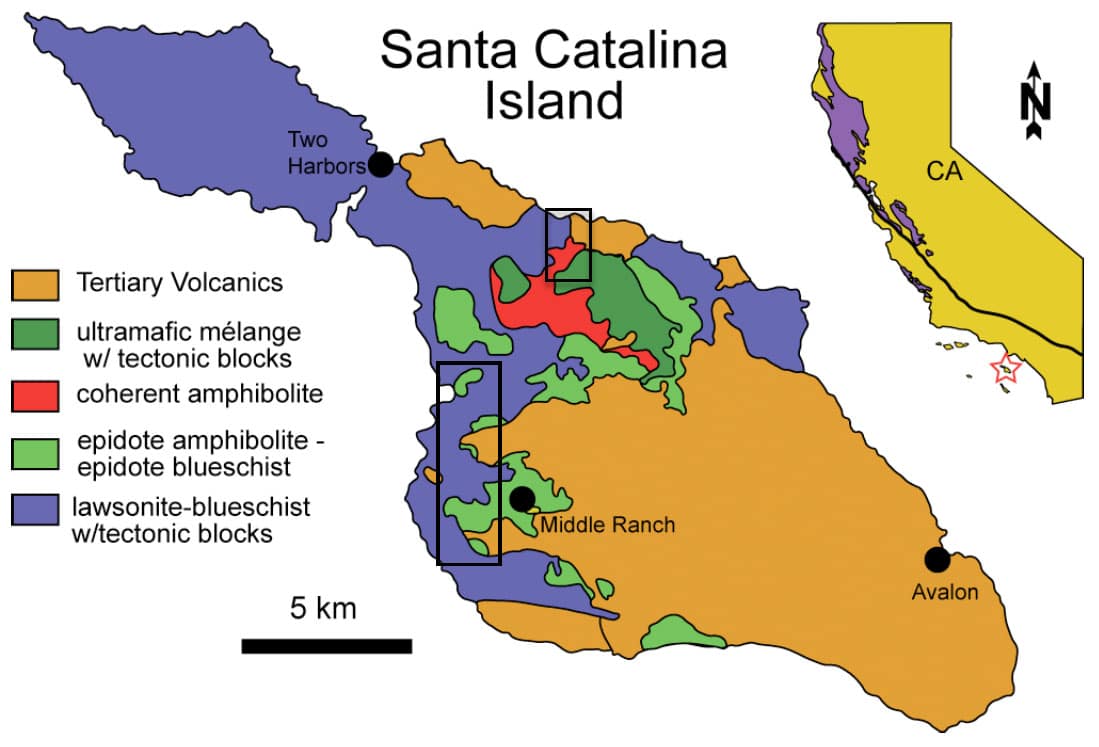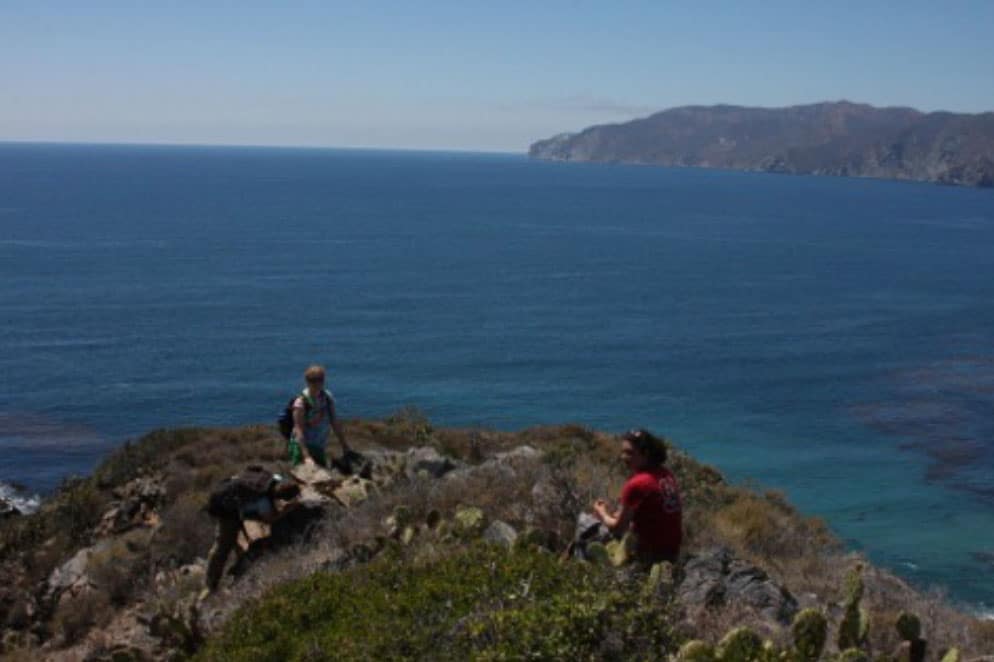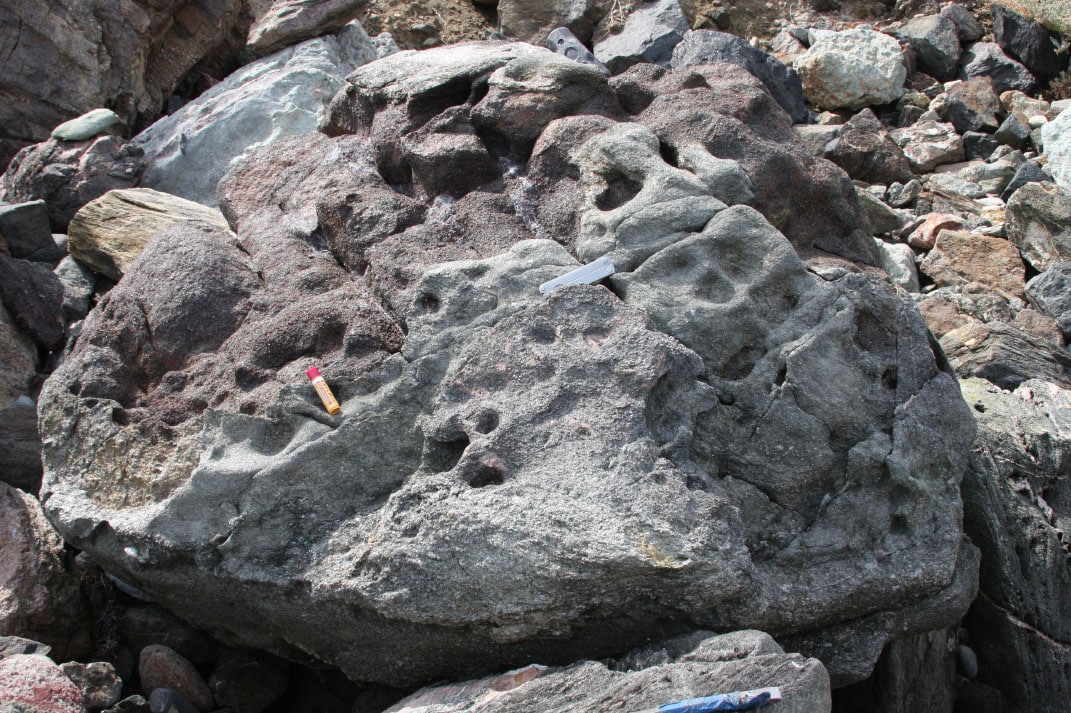Using garnets to explore the beginning of subduction on Santa Catalina Island, California
Overview: In the late Cretaceous Period, before the San Andreas Fault started shearing off the edge of California, the geology of the Los Angeles region probably looked a lot more like the Pacific Northwest does now, with lines of volcanoes stretching all the way south from what is now Canada. These volcanoes were caused by the subduction of the Pacific Plate under North America. As the dense oceanic crust slid down into the mantle, it metamorphosed, growing new minerals and releasing water, which triggered melting, creating the arc of magmatism above. After subduction ended, more modern tectonic activity exhumed a remnant of the rocks that formed above the subducting plate, becoming Santa Catalina Island. Catalina has long been a laboratory for understanding the structure of subduction zones and how the fluids released during subduction change the composition of rocks. During the Catalina Gateway project, we will learn about the geochemistry of subduction zones, explore the island that has helped shape our understanding of how subduction works, and decipher the record of these chemical changes using the chemistry of the mineral garnet.

Geologists taking notes on Catalina Island
When: June 25 – July 27, 2018 (tentative)
Where: Oberlin, Ohio (introduction and lab work), Santa Catalina Island, California (field work), and Claremont, California (lab work)
Who: Nine students and project leaders Dr. Zeb Page (Oberlin College, zeb.page@oberlin.edu), and Dr. Jade Star Lackey (Pomona College, JadeStar.Lackey@pomona.edu)
Prerequisites and Recommended Courses: Curiosity and excitement about our planet. Interest in learning how to use new tools from rock hammers to electron microscopes and mass spectrometers to figure out what was happening off the California coast 115 million years ago. Ability to work collaboratively with others. The rest we will learn as we go.
Expectations and Obligations:
1. Participation in all project-related work during the summer (June 25-July 27, 2018)
2. Commitment to work collaboratively in an environment of mutual respect.
3. Adherence to mutually agreed upon community standards of conduct we will collectively develop at the beginning of the project.
PROJECT DESCRIPTION
Franciscan-like subduction-related metamorphic rocks (blocks of garnet-bearing blueschist and amphibolite) were recognized on Catalina by the first half of the twentieth century (Woodford, 1924; Bailey, 1941). However, the modern era of Catalina geology began with detailed mapping and a tectonic model by Platt (1975). The metamorphic rocks of Santa Catalina Island (sometimes referred to as the Catalina Schist) consist of mappable units of dominantly metsedimentary rock that range from lawsonite-blueschist to amphibolite facies, with increasing grade correlated with structural height (Platt, 1975). Platt’s initial subdivision of the island into blueschist, greenschist, amphibolite, and ultramafic units bounded by shallow dipping thrust faults (Fig. 1) has been refined, with the “greenschist” unit now defined as epidote amphibolite and epidote blueschist overprinted with greenschist-facies assemblages (Grove and Bebout, 1995).

Figure 1: Geologic sketch map of Santa Catalina Island, California, modified from Platt (1975) and Grove and Barton (1995). The location of Catalina Island is shown in the red star on the inset map; the Franciscan Complex is shown in purple. The proposed study areas are shown in black rectangles.
The highest-grade amphibolite unit from Catalina records peak conditions of 7-12 kbar and 650-750 °C based on cation thermometry and fluid inclusion barometry (Platt, 1975; Sorensen and Barton, 1987). The unusually high temperatures and Barrovian-like assemblages of the highest-grade rocks became the basis for the interpretation that the Catalina Schist was formed in a nascent subduction zone. In this model, the amphibolite-facies rocks were formed at the initiation of subduction and recorded high temperatures due to proximity with the hot mantle wedge; the inverted metamorphic gradient of underthrust lower-grade units recorded the subsequent cooling of the trench (Platt, 1975; Cloos, 1985; Peacock, 1987). More recent analysis of detrital zircon ages from Catalina metasedimentary rocks has revealed that accretion of the Catalina Schist occurred over at least a 20 My period, with the lowest-grade units containing detrital zircons younger than the 115 Ma metamorphic age yielded by the high-grade rocks (Grove et al., 2008). Furthermore, a single garnet blueschist block (Fig. 2) found in the blueschist-facies mélange yielded high-error Rb-Sr and Ar-Ar ages of ~150 Ma suggesting that a pre-Catalina subduction zone existed in the region. The age of the garnet blueschist block was firmly established by a 155±8 U-Pb sphene age collected during the 2012 Keck project (Awalt et al., 2013). However, the P-T history of this key sample remains unconstrained, possibly due to multiple episodes of subduction as the Catalina trench become superimposed on the remnants of a thermally mature subduction zone through subduction erosion (Grove et al., 2008).

Figure 2: Tectonic block of garnet blueschist in a lawsonite blueschist mélange that may have experienced multiple episodes of subduction metamorphism.
Santa Catalina Island has long been used as a field laboratory to investigate devolatilization and fluid flow in subduction zones. Petrologic, geochemical, and chronological constraints on Santa Catalina Island have been used to document extensive fluid flow and metasomatism due to devolatilization of sediments during subduction (e.g., Sorensen and Grossman, 1989; Bebout, 1991; 2007; King et al., 2006, 2007). Many blocks in the amphibolite/ultramafic mélange have talc or tremolite metasomatic selvages or reaction rinds similar to those found in the Franciscan Complex. Unlike in the Franciscan, some of these selvages contain garnet that is compositionally different from that found in the blocks (Penniston-Dorland et al., 2013). In situ analysis of oxygen isotopes based on samples collected during the 2012 Keck Project has demonstrated that selvages contain garnet that grew both before and after rind formation (Leung et al., 2016). These garnets likely contain further information on the P-T history of rind formation and on the trace element composition of rind forming fluids.
As the scientific research component of the proposed gateway project, we will have students work collectively on three projects that will use in situ analysis of major and trace elements to address questions of tectonics (timing of garnet vs. lawsonite growth in garnet blueschist, trace element zoning in amphibolite garnets with variable inclusion populations) and metasomatism (major and trace elements in rind garnets). The specifics of these projects are detailed below.
As a Gateway project, we expect that students applying will only have 1-2 geology courses under their belt, so you can expect to learn the essential geology on as you go, and more importantly how to work with a team of other budding geoscientists. We’ll also give you insight into how the multitude of career prospects in Geosciences and pathways into them.
Active learning of foundational geology/geochemistry concepts
Students in the Gateway Project may come to the group with varying degrees of geology training, and we recognize that many may only have taken a single, introductory course (or may have had no geology at all). Furthermore, experience shows that many students come to geochemical research with uneven quantitative skills…perhaps most notably in the use of spreadsheets for calculations and data management. Thus, we plan to spend a substantial portion of the first 2.5 weeks of the program reviewing specific aspects of introductory geology and quantitative skills. We will do this through labs and field trips to local sites of interest. The five topics we intend to cover at a basic, introductory level are: geologic time, earth materials (with a specific focus on metamorphic rocks and their minerals) and plate tectonics. Obviously in just a few days at Oberlin we cannot cover these in great depth, but we can use these lab and field activities as inquiry based teaching to ensure a somewhat more level playing field for all the students. A typical morning in the first phase of the project might be spent doing the classic plate tectonics map jigsaw exercise, reviewing metamorphic minerals, or a field trip to a local river to brainstorm how one might measure discharge…followed by getting in and doing it. The afternoon would include time spent on the electron microscope analyzing traverses of zoned garnet by EDS, or calculating mineral formulae.
Potential Student Projects
We propose three collaborative student research projects based on major and trace-element data from garnet and other minerals in Catalina blocks and rinds. Each project has some relatively straightforward hypotheses that are testable using the major and trace element data students will collect. This should ensure a relatively high likelihood of success for a meaningful conclusion of tectonic or metasomatic interest beyond simply descriptive work. The projects will have three phases: 1. At Oberlin: Introduction to SEM/EDS and data collection from existing samples from Catalina, begin GSA abstract(s) and poster(s). 2. On Catalina Island: A field component in which students will visit their sample sites, and perform a second phase of sampling guided by their lab work in phase one. Although this “inside-out” approach to geology research is not optimal, it seems the most efficient use of the five weeks available. 3. A final phase on campus at Pomona to collect trace element data by LA-ICPMS on targets previously characterized at Oberlin, to analyze selected “new” samples in quickly prepared thick sections and to obtain major and trace element compositions on these by X-ray fluorescence spectrometry while students finalize abstracts and print and present posters.
Relative timing of garnet and lawsonite growth in blueschist (3 students)
As described above, a large garnet, lawsonite blueschist block (Figure 2) with an anomalously old age is a key sample in understanding the tectonic history of Catalina. Preliminary attempts at thermodynamic modeling in order to reconstruct the pressure-temperature evolution of the rock did not succeed in reproducing the observed metamorphic assemblage. One possibility is that the garnet and dated sphene formed in an early metamorphism at 155Ma, and the lawsonite and glaucophane recrystallized in a second lawsonite-blueschist metamorphism after 115Ma. This is consistent with color zonation in glaucophane (Awalt et al., 2013). Students will collaborate on a detailed SEM/EDS petrography of the sample, including characterizing any chemical zoning in minerals. A first order question in the analysis of this rock is whether the garnet or lawsonite grew first, or if they grew in equilibrium. Work on the Lu-Hf geochronology of lawsonite has shown that both garnet and lawsonite strongly partition the Heavy Rare Earth Elements (HREE, Mulcahy et al., 2014)). Students will choose garnet and lawsonite targets while at Oberlin and analyze them for HREE at Pomona in order to address this issue, HREE depletion in either lawsonite or garnet is suggestive of growth in separate events.
A high-resolution garnet view of high-T metamorphism on Catalina (3 students)
Although most Catalina garnet-hornblende rocks contain <5mm diameter garnets, an unusual sample containing ~3cm garnets was collected during the 2012 Keck project. These garnets are chemically zoned, and contain ilmenite inclusions in their cores and rutile inclusions in their rims, demonstrating growth in an increasing pressure regime. Students will characterize the chemistry and identity of mineral inclusions in single large garnets and note correlations between changing garnet chemistry and inclusion populations. Depending on student interest and time constraints, students may apply quantitative thermobarometry to inclusion-garnet assemblages. At Pomona, students will look at correlations between trace elements and changing inclusion populations, as well as compare their results with those from other groups. They will also compare their results with the single existing published analysis of trace elements in Catalina (Sorenson and Grossman, 1989).
Comparing block and rind garnets (3 students)
Leung et al. (2016) documented three different generations of garnets in a single rind sample from one block (Fig. 3) on Catalina, first described by Penniston-Dorland et al., (2013). Three students will work collaboratively to describe the mineralogy of a block and two samples of garnet-bearing rind. They will compare major element chemistry and zoning patterns with those found in published works as well as the other group working on amphibolite garnet. They will determine if different populations of garnet that can be distinguished texturally and by oxygen isotope ratios have different trace-element patterns. they will also compare their results with Sorensen and Grossman (1989).

Figure 3: A garnet-hornblende tectonic block with garnet-bearing actinolite rind. Block core is exposed above chapstick tube (~5cm), rind below and to the right.
PROJECT LOGISTICS
The first 2.5 weeks will be spent on campus at Oberlin College. During this time our objectives will include team building through introductory geology exercises and field trips with a focus on minerals and metamorphic rocks. We will dip our toes into the scientific literature and collect major element data on samples collected in 2012 on the SEM/EDS. The new Tescan-Oxford system at Oberlin can collect data in an automated fashion overnight, and students will spend time using the instrument in the afternoons and “data mining” maps collected overnight. As students develop an understanding of their projects and begin to collect data we will start to draft abstracts. We anticipate this will be a busy time, but will be sure to build in fun activities as well.
Page and the students will travel to Los Angeles together, meet Lackey at Pomona College to organize field equipment, and travel to Catalina en mass. The week on Catalina will start with field trips to get the lay of the land, and make observations of metamorphic rocks in the field. We will visit the outcrops that were sampled previously to talk about sampling strategy, and take a second round of samples informed by the observations already made by the students in the lab. Finally, there are several mélange units with blocks described in the Catalina literature of the 1970’s and 80’s (e.g., Pomona alumna Sorena Sorensen, 1986) that have not been worked on more recently, and we will take two days to do some reconnaissance work on the SW side of the island, in part to acquaint the students of how to approach a new field area (as opposed to a more guided field trip). The proposed field area is part of the 88% of Catalina Island that is privately owned and managed by the Catalina Island Conservancy. Private motor vehicles are not allowed, and all research must be permitted by the Conservancy. An extension of Page’s permit is straightforward to obtain, and we have already started this process. Last year the Conservancy provided camping and transportation support, and will again for this field season. Field equipment (Hammers, Bruntons, Trimble GeoXT handheld GPS receivers for detailed mapping) will be provided by Oberlin, and Pomona Colleges. As part of our orientation on the island, Conservancy staff will give us an overview of the important biological (a rare, undeveloped island ecosystem 25 miles from downtown LA) and cultural (>7000 years of pre-colonial habitation) aspects of Catalina. We will stress the importance of the permitting process and ethical behavior when sampling in culturally sensitive areas.
The final 1.5 weeks will be spent on campus at Pomona. There students will become familiarized with the LA-ICPMS system, including methods of standardization, instrument evaluation of data quality. They will analyze garnet and other minerals already identified at Oberlin, and reduce and correct trace element data using major element compositions already collected by SEM-EDS. Teams of students will rotate between ICP-MS work, preparation of XRF beads for whole rock chemistry, and interpretation of data. They will finish drafting abstracts and posters, and, we hope, have time for some local field trips, for example to the costal exposures of the San Onofre Breccia, which contains Catalina equivalent cobbles and gives to students a historical introduction of the discovery of subduction metamorphism as well as initiation of the San Andreas Fault system.
PROFESSIONAL DEVELOPMENT
Conducting a research project at an early career stage is not only a résumé-builder, but helps to develop many skills that are applicable after the summer is over. Working and living together in the field, collaboratively completing a project from start to finish, and starting to develop a network of friends and colleagues all build resiliency, capabilities, and cognitive abilities. This Gateway Keck project offers these experiences in a supportive yet challenging environment. Students will work on real scientific questions, using standard and state-of-the art field and lab equipment; they will also receive training in science communication, including informal interactions with the public in the field, and more formal methods of presenting information such as lightning talks and giving better, more engaging research presentations.
References
Awalt, M.B., Page, F.Z., Walsh, E.O., Kylander-Clark, A.R.C., and Wirth, K.R., 2013, New evidence for old subduction in the Catalina Schist, Santa Catalina Island, CA: Geological Society of America Abstracts with Programs, v. 45, p. 798.
Bailey, E.H., 1941, Mineralogy, petrology, and geology of Catalina Island, California: Ph.D. Thesis, Stanford University.
Bebout, G.E., 1991, Field-based evidence for devolatization in subduction zones; implications for arc magmatism: Science, v. 251, p. 413–416.
Bebout, G.E., 2007, Metamorphic chemical geodynamics of subduction zones: Earth and Planetary Science Letters, v. 260, no. 3-4, p. 373–393.
Cloos, M., 1985, Thermal Evolution of Convergent Plate Margins – Thermal Modeling and Reevaluation of Isotopic Ar-Ages for Blueschists in the Franciscan Complex of California: Tectonics, v. 4, p. 421–433.
Grove, M., and Bebout, G., 1995, Cretaceous tectonic evolution of coastal southern California: Insights from the Catalina Schist: Tectonics, v. 14, p. 1290–1308.
Grove, M., Bebout, G.E., Jacobson, C., Barth, A., Kimbrough, D., King, R.L., Zou, H., Lovera, O., Mahoney, B., and Gehrels, G.E., 2008, The Catalina Schist: Evidence for middle Cretaceous subduction erosion of southwestern North America, in Formation and Applications of the Sedimentary Record in Arc Collision Zones: Geological Society of America Special Paper 436, p. 335–361.
King, R.L., Bebout, G.E., Moriguti, T., and Nakamura, E., 2006, Elemental mixing systematics and Sr-Nd isotope geochemistry of melange formation: Obstacles to identification of fluid sources to arc volcanics: Earth and Planetary Science Letters, v. 246, p. 288–304.
King, R.L., Bebout, G.E., Grove, M., Moriguti, T., and Nakamura, E., 2007, Boron and lead isotope signatures of subduction-zone melange formation: Hybridization and fractionation along the slab-mantle interface beneath volcanic arcs: Chemical Geology, v. 239, p. 305–322.
Leung, M.C., Page, F.Z., Penniston-Dorland, S.C., Kitajima, K., and Valley, J.W., 2016, Constraints on garnet-bearing metasomatic rind growth in subduction mélange through SIMS analysis of oxygen isotopes, in Geological Society of America, p. 281880–1.
Mulcahy, S.R., Vervoort, J., and Renne, P.R., 2014, Dating subduction-zone metamorphism with combined garnet and lawsonite Lu-Hf geochronology: Journal of Metamorphic Geology, v. 32, no. 5, p. 515–533, doi: 10.1111/jmg.12092.
Peacock, S., 1987, Creation and Preservation of Subduction-Related Inverted Metamorphic Gradients: Journal of Geophysical Research-Solid Earth and Planets, v. 92, p. 12763–12781.
Penniston-Dorland, S.C., Gorman, J.K., Bebout, G.E., Piccoli, P.M., and Walker, R.J., 2014, Reaction rind formation in the Catalina Schist: Deciphering a history of mechanical mixing and metasomatic alteration: Chemical Geology, v. 384, no. C, p. 47–61, doi: 10.1016/j.chemgeo.2014.06.024.
Platt, J.P., 1975, Metamorphic and deformational processes in the Franciscan Complex, California: some insights from the Catalina Schist terrane: Bulletin of the Geological Society of America, v. 86, p. 1337–1347.
Sorensen, S.S., 1986, Petrologic and geochemical comparison of the blueschist and greenschist units of the Catalina Schist Terrane, southern California, in Evans, B.W. and Brown, E.H. eds. Blueschists and Eclogites: Geological Society of America Memoir 164, Geological Society of America, p. 59–75.
Sorensen, S.S., and Grossman, J., 1989, Enrichment of trace elements in garnet amphibolites from a paleo-subduction zone: Catalina Schist, Southern California: Geochimica et Cosmochimica Acta, v. 53, p. 3155–3177.
Sorensen, S.S., and Barton, M., 1987, Metasomatism and Partial Melting in a Subduction Complex – Catalina Schist, Southern California: Geology, v. 15, p. 115–118.
Woodford, A.O., 1924, The Catalina metamorphic facies of the Franciscan Series: University of California Publications in Geological Sciences, v. 15, p. 49–68.

